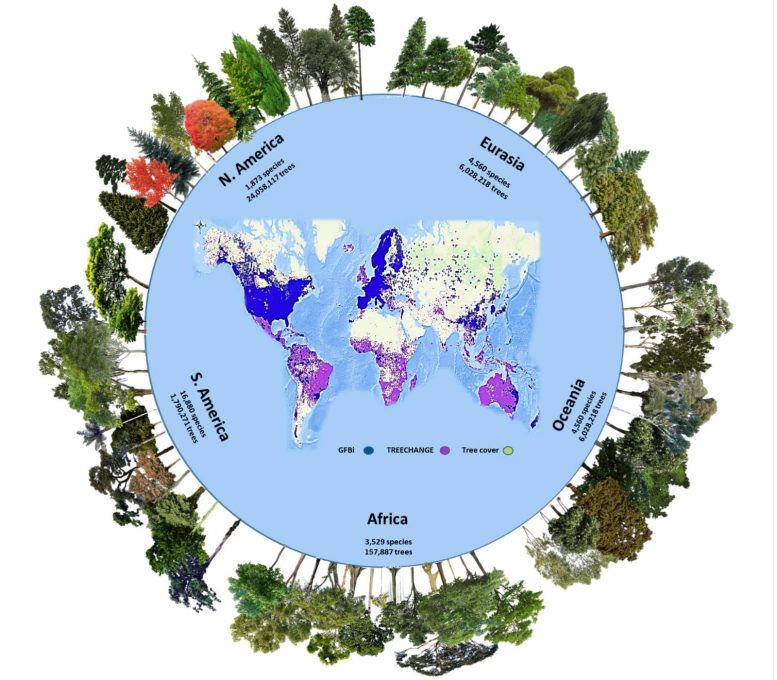
This dataset (blue points in the central map) was used for the parametric estimation and merged with the TREECHANGE occurrence-based data (purple points in the central map) to provide the estimates in this study. Green areas represent the global tree cover. Credit: From Cazzolla Gatti et al. in PNAS, 2022
Our planet might be hosting approximately 9,000 tree species yet to be discovered. A third of these are rare species with a population that is restricted both in terms of numbers and areas. This is one of the results of the first-ever estimate of tree species richness at the global level.
The study was published in the PNAS journal and is the outcome of a three-year international project that counted approximately 73,000 tree species currently existing on earth. This study emphasizes the richness of terrestrial ecosystems and, at the same time, it underlines how forest biodiversity is extremely vulnerable to human-induced changes — from land-use to the climate crisis — and rare species are the most at risk.
“Extensive knowledge of tree richness and diversity is key to preserving the stability and functionality of ecosystems,” explains Roberto Cazzolla Gatti who is the first author of this study and a professor at the Department of Biological, Geological and Environmental Sciences of the University of Bologna. “Until today, our data regarding wide areas of the planet was very limited and based on field-observation and lists of species covering different areas. These limitations were detrimental to a global perspective on the issue.”
However, reaching this type of knowledge is no small feat. There are many factors at play, some related to money availability, some to logistics, some to field-research, and some other to issues regarding the taxonomies. To overcome these hurdles, first researchers collected the most extensive databases of forest tree species. This mapping operation identified approximately 40 million trees belonging to 64,000 species. It involved 150 scientists all over the world and was carried out within the Global Forest Biodiversity Initiative (GFBI).
Based on this preliminary result, researchers performed complex statistical analyses by using artificial intelligence and the supercomputer of the Forest Advanced Computing and Artificial Intelligence (FACAI) Laboratory of Purdue University in Indiana (USA).
Once these analyses and calculations were completed, researchers estimated that our planet has approximately 73,300 tree species, 14% more than those currently known.
“We combined individual datasets, coming from someone going out to a forest stand and measuring every single tree, into one massive global dataset of tree-level data. Counting the number of tree species worldwide is like a puzzle with pieces spreading all over the world. We, the Global Forest Biodiversity Initiative (GFBI), solved it together as a team, each sharing our own piece,” said professor Jingjing Liang, coordinator of the GFBI Purdue-Hub and co-author of the paper.
According to these results, there are still 9,000 unknown species, 40% of them could be in South America, more specifically in the two biomes composed of “grasslands, savannas, and shrublands” and “tropical and subtropical forests” of the Amazon and the Andes. Approximately 3,000 of those species are rare, endemic on the continent, and populate tropical and sub-tropical areas.
“To get a reliable estimate of biodiversity, we need to pay attention to the number of rare species that are currently known, those that were found one, two or three times during the sampling on the field,” explains Cazzolla Gatti. “Indeed, most of the species are quite common and numerous, there are a few rare ones and even less are those that we don’t know. If many species have been observed only a few times, there will probably be many rare species that have not yet been documented.”
Scientists applied this approach to the available databases, both on the continental and global scale, estimated the number of unknown tree species and identified the areas of the world in which they are likely to be discovered.
“These results highlight the vulnerability of global forest biodiversity to anthropogenic changes, particularly land use and climate, because the survival of rare taxa is disproportionately threatened by these pressures”, said Peter B. Reich, regent professor at the University of Minnesota and co-author of the study.
The study was published in the journal PNAS under the title “The number of tree species on Earth.” First author of the paper is Roberto Cazzolla Gatti, professor at the Department of Biological, Geological, and Environmental Sciences of the University of Bologna.
For more on this research, see Huge New Study Estimates There Are 9,200 Tree Species on Earth Yet To Be Discovered.
Reference: “The number of tree species on Earth” by Roberto Cazzolla Gatti, Peter B. Reich, Javier G. P. Gamarra, Tom Crowther, Cang Hui, Albert Morera, Jean-Francois Bastin, Sergio de-Miguel, Gert-Jan Nabuurs, Jens-Christian Svenning, Josep M. Serra-Diaz, Cory Merow, Brian Enquist, Maria Kamenetsky, Junho Lee, Jun Zhu, Jinyun Fang, Douglass F. Jacobs, Bryan Pijanowski, Arindam Banerjee, Robert A. Giaquinto, Giorgio Alberti, Angelica Maria Almeyda Zambrano, Esteban Alvarez-Davila, Alejandro Araujo-Murakami, Valerio Avitabile, Gerardo A. Aymard, Radomir Balazy, Chris Baraloto, Jorcely G. Barroso, Meredith L. Bastian, Philippe Birnbaum, Robert Bitariho, Jan Bogaert, Frans Bongers, Olivier Bouriaud, Pedro H. S. Brancalion, Francis Q. Brearley, Eben North Broadbent, Filippo Bussotti, Wendeson Castro da Silva, Ricardo Gomes César, Goran Cešljar, Víctor Chama Moscoso, Han Y. H. Chen, Emil Cienciala, Connie J. Clark, David A. Coomes, Selvadurai Dayanandan, Mathieu Decuyper, Laura E. Dee, Jhon Del Aguila Pasquel, Géraldine Derroire, Marie Noel Kamdem Djuikouo, Tran Van Do, Jiri Dolezal, Ilija Ð. Ðordevic, Julien Engel, Tom M. Fayle, Ted R. Feldpausch, Jonas K. Fridman, David J. Harris, Andreas Hemp, Geerten Hengeveld, Bruno Herault, Martin Herold, Thomas Ibanez, Andrzej M. Jagodzinski, Bogdan Jaroszewicz, Kathryn J. Jeffery, Vivian Kvist Johannsen, Tommaso Jucker, Ahto Kangur, Victor N. Karminov, Kuswata Kartawinata, Deborah K. Kennard, Sebastian Kepfer-Rojas, Gunnar Keppel, Mohammed Latif Khan, Pramod Kumar Khare, Timothy J. Kileen, Hyun Seok Kim, Henn Korjus, Amit Kumar, Ashwani Kumar, Diana Laarmann, Nicolas Labrière, Mait Lang, Simon L. Lewis, Natalia Lukina, Brian S. Maitner, Yadvinder Malhi, Andrew R. Marshall, Olga V. Martynenko, Abel L. Monteagudo Mendoza, Petr V. Ontikov, Edgar Ortiz-Malavasi, Nadir C. Pallqui Camacho, Alain Paquette, Minjee Park, Narayanaswamy Parthasarathy, Pablo Luis Peri, Pascal Petronelli, Sebastian Pfautsch, Oliver L. Phillips, Nicolas Picard, Daniel Piotto, Lourens Poorter, John R. Poulsen, Hans Pretzsch, Hirma Ramírez-Angulo, Zorayda Restrepo Correa, Mirco Rodeghiero, Rocío Del Pilar Rojas Gonzáles, Samir G. Rolim, Francesco Rovero, Ervan Rutishauser, Purabi Saikia, Christian Salas-Eljatib, Dmitry Schepaschenko, Michael Scherer-Lorenzen, Vladimír Šeben, Marcos Silveira, Ferry Slik, Bonaventure Sonké, Alexandre F. Souza, Krzysztof Jan Sterenczak, Miroslav Svoboda, Hermann Taedoumg, Nadja Tchebakova, John Terborgh, Elena Tikhonova, Armando Torres-Lezama, Fons van der Plas, Rodolfo Vásquez, Helder Viana, Alexander C. Vibrans, Emilio Vilanova, Vincent A. Vos, Hua-Feng Wang, Bertil Westerlund, Lee J. T. White, Susan K. Wiser, Tomasz Zawila-Niedzwiecki, Lise Zemagho, Zhi-Xin Zhu, Irié C. Zo-Bi, and Jingjing Liang, 31 January 2022, Proceedings of the National Academy of Sciences.
DOI: 10.1073/pnas.2115329119

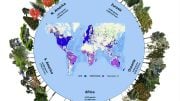
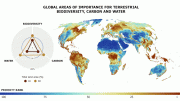

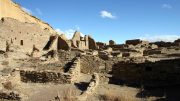
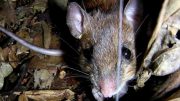

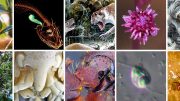

Be the first to comment on "Earth May Have 9,000 Tree Species That Haven’t Been Discovered Yet"